Fresh Off the 3D Printer: Henry Segerman’s Mathematical Sculptures
A research fellow at the University of Melbourne has found a sneaky way to convert math haters to math lovers. He turns complex geometries into art
/https://tf-cmsv2-smithsonianmag-media.s3.amazonaws.com/filer/66/87/668722f0-3fa1-4107-a475-9c1fd2b6cf9d/bunny.jpg)
To say that Henry Segerman is schooled in mathematics is an understatement. The 33-year-old research fellow at the University of Melbourne, in Australia, earned a master’s degree in math at Oxford and then a doctorate in the subject at Stanford. But the mathematician moonlights as an artist. A mathematical artist. Segerman has found a way to illustrate the complexities of three-dimensional geometry and topology—his areas of expertise—in sculptural form.
First things first…three-dimensional geometry and topology?
“It is about three-dimensional stuff, but not necessarily easy to visualize three-dimensional stuff,” says Segerman, when we talk by phone. “Topology is sort of split along low-dimensional stuff, which usually means two, three and four dimensions, and then high-dimensional stuff, which is anything higher. There are fewer pictures in the high-dimensional stuff.”
Since 2009, Segerman has made nearly 100 sculptures that capture, as faithfully as is physically possible, some of these hard-to-grasp lower-dimensional mathematical concepts.He uses a 3D modeling software called Rhinoceros, typically used to design buildings, ships, cars and jewelry, to construct shapes, such as Möbius strips, Klein bottles, fractal curves and helices. Then, Segerman uploads his designs to Shapeways.com, one of a few 3D printing services online. “It is really easy,” he says. “You upload the design to their Web site. You hit the ‘add to cart’ button and a few weeks later it arrives.”
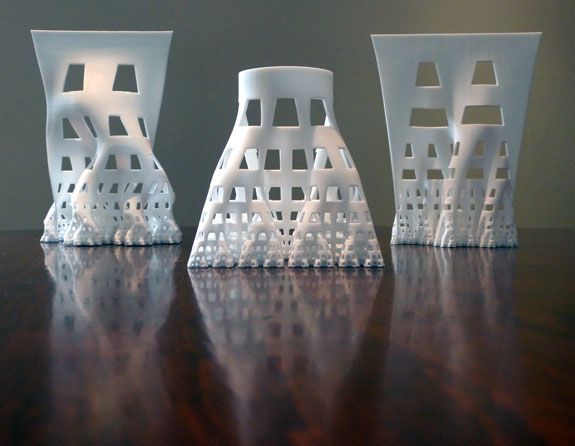
Before 3D printing, Segerman built knots and other shapes in the virtual world, Second Life, by writing little bits of programming. “What cool things can I make in 3D?” he recalls asking himself. “I had never played around with a 3D program before.” But, after a few years, he reached the limit of what he could do within that system. If he wanted to show someone a complicated geometric shape, that person needed to download it to his or her computer, which seemed to take ages.
“That is the big advantage of 3D printing. There is an awful lot of data in there, but the real world has excellent bandwidth,” says Segerman. “Give someone a thing, and they see it immediately, with all its complexity. There is no wait time.”
There is also something to holding the shape in your hand. Generally speaking, Segerman designs his sculptures to fit in someone’s palm. Shapeways then prints them in nylon plastic or a costlier steel bronze composite. The artist describes the 3D printing process, for his white plastic pieces:
“The 3D printer lays down a thin layer of plastic dust. Then, it’s heated up so that it is just under the melting point of plastic. A laser comes along and melts the plastic. The machine lays down another layer of dust and zaps it with a laser. Do that again and again and again. At the end, you get this vat filled with dust, and inside the dust is your solid object.”
While his primary interest is in the mathematical idea driving each sculpture, and in conveying that idea in as simple and clean a way as possible (“I tend towards a minimalist aesthetic,” he says), Segerman admits that the shape has to look good. A Hilbert curve, the 3-sphere—these are esoteric mathematical concepts. But, Segerman says, “You don’t need to understand all of the complicated stuff in order to appreciate the object.”
If viewers find a sculpture visually appealing, then Segerman has something to work with. “You’ve got them,” he says, “and you can start telling them about the mathematics behind it.”
Here are a few selections from Segerman’s large body of work:
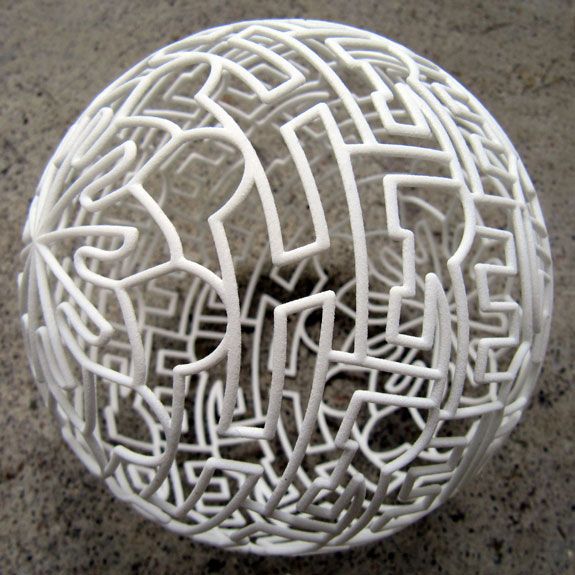
Segerman made up the word “autologlyph” to describe sculptures, such as “Bunny” Bunny, pictured at the very top, and this sphere, above. By the artist’s definition, an autologlyph “a word, which is written in a way that is described by the word itself.” With “Bunny” Bunny, Segerman used the word “bunny,” repeated many times over, to form a sculpture of the Stanford Bunny, a standard test model for 3D computer graphics. Then, in the case of this sphere autologlyph, block letters spelling the word “sphere” create the sphere. Minus the bunny, many of Segerman’s autologlyphs have a mathematical slant, in that he tends to use words that describe a shape or some sort of geometric feature.
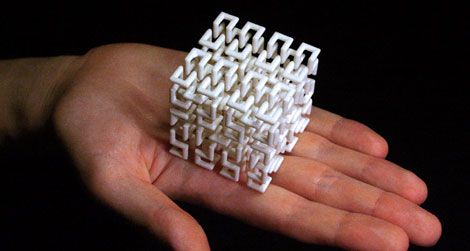
This cube, shown above, is Segerman’s take on a Hilbert curve, a space-filling curve named for David Hilbert, the German mathematician who first wrote about the shape in 1891. “You start with a curve, really a straight line that turns right angle corners,” says the artist. “Then, you change the curve, and you make it squigglier.” Remember: Segerman does these manipulations in a modeling software program. “You do this infinitely many times and what you get at the end is still some sense a one dimensional object. You can trace along it from one end to the other,” he says. “But, in another sense, it looks like a three-dimensional object, because it hits every point in a cube. What does dimension mean anymore?” Hilbert and other mathematicians became interested in curves like these in the late 19th century, since the geometries called into question their assumptions about dimensions.
“I had been looking at this thing on a computer screen for a year, and when I first got it from Shapeways, and picked it up, it was only then that I realized it was flexible. It is really springy,” says Segerman. “Sometimes the physical object surprises you. It has properties that you didn’t imagine.”
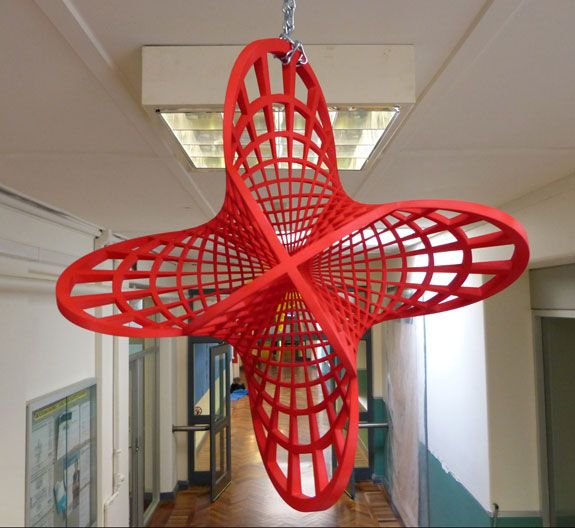
Round Klein Bottle is a sculpture, much larger than Segerman’s typical pieces, that hangs in the Department of Mathematics and Statistics at the University of Melbourne. (The artist applied a red spray dye to the nylon plastic material for effect.) The object itself was designed in something called the 3-sphere. Segerman explains:
“The usual sphere that you think of, the surface of the earth, is what I would call the 2-sphere. There are two directions you can move. You can move north-south or east-west. The 2-sphere is the unit sphere in three-dimensional space. The 3-sphere is the unit sphere in four-dimensional space.”
In the 3-sphere, all the squares in the grid patterning of this Klein bottle are equal in size. Yet, when Segerman translates this data from the 3-sphere to our ordinary three-dimensional space (Euclidean space) things get distorted. “The standard Mercator map has Greenland being huge. Greenland is the same size as Africa , whereas in reality, Greenland is much smaller than Africa. You are taking a sphere and trying to lay it flat. You have to stretch things. That is why you can’t have a map of the world which is accurate, unless you have a globe,” says Segerman. “It is exactly the same thing here.”
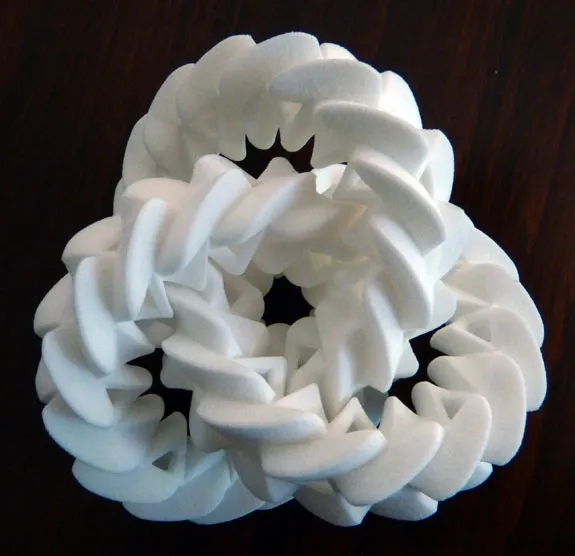
Segerman is now toying with the idea of moving sculptures. Triple Gear, shown here, consists of three rings, each with gear teeth. The way it is set up, no single ring can turn on its own; all three have to be moving simultaneously. As far as Segerman knows, no one has done this before.
“It is a physical mechanism that would have been very difficult to make before 3D printing,” says the artist. “Even if someone had the idea that this was possible, it would have been a nightmare to try to build such a thing.”
/https://tf-cmsv2-smithsonianmag-media.s3.amazonaws.com/accounts/headshot/megan.png)
/https://tf-cmsv2-smithsonianmag-media.s3.amazonaws.com/accounts/headshot/megan.png)